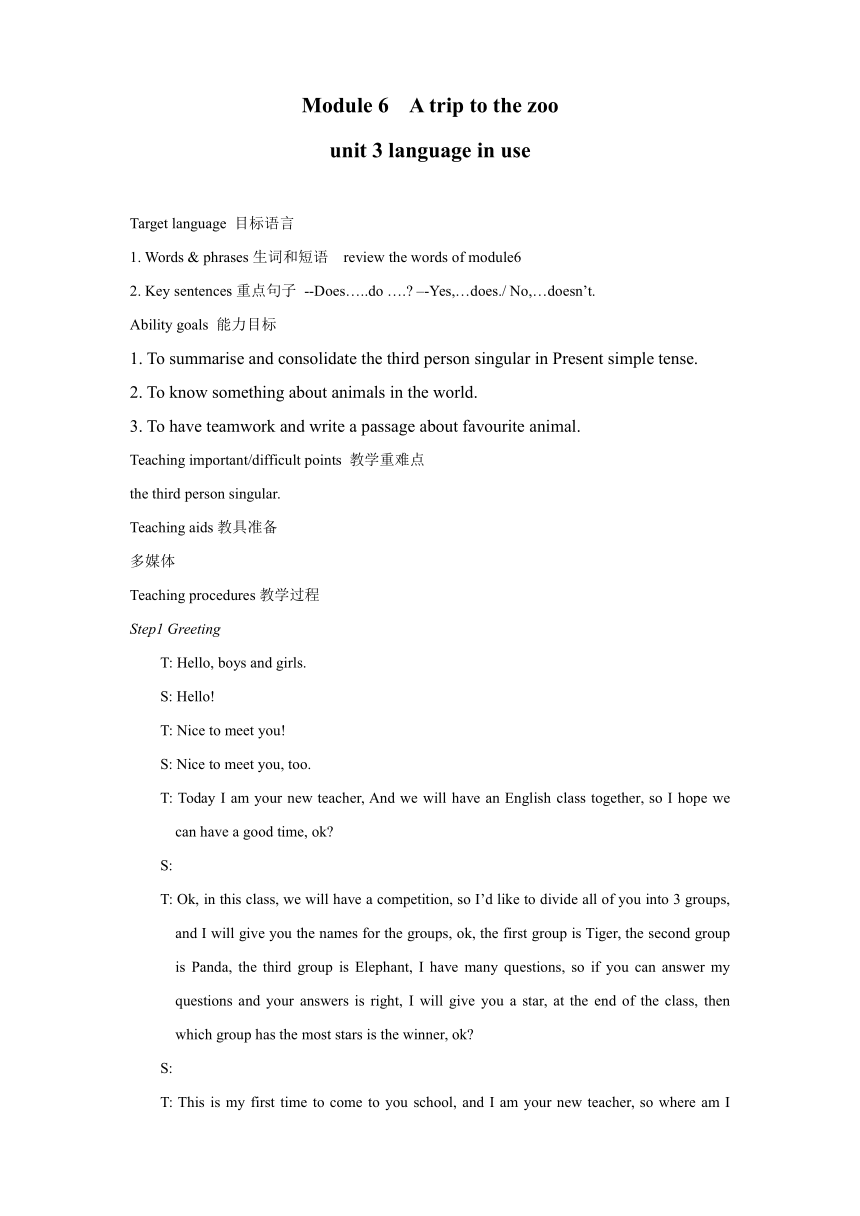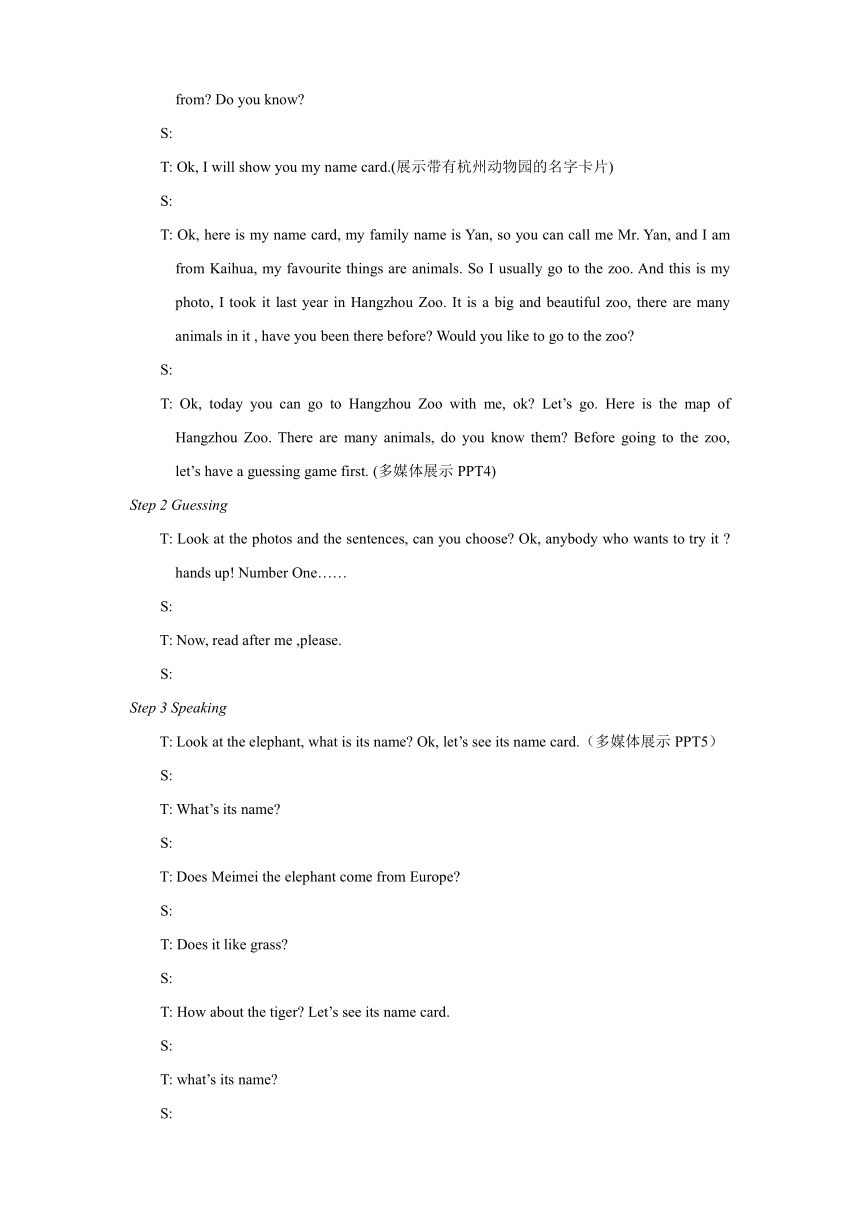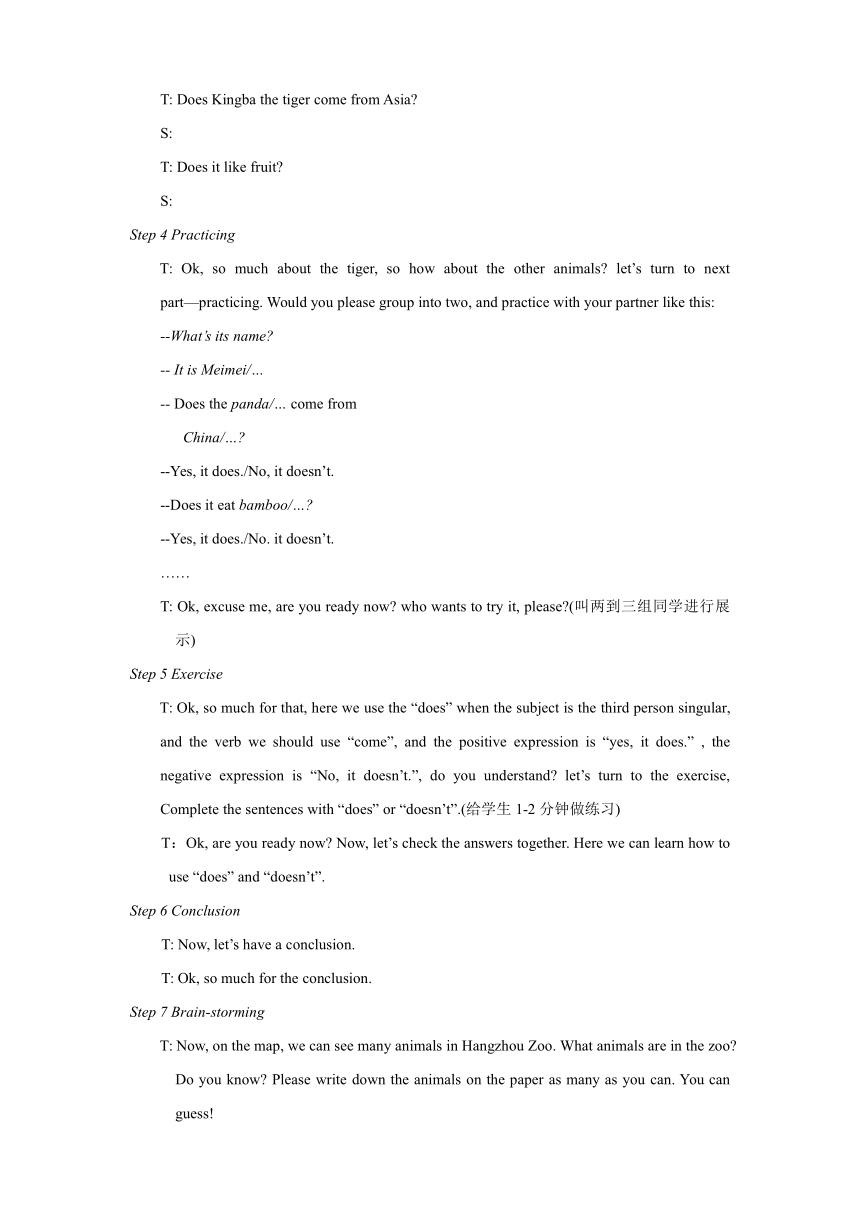外研版七上:Module 6 Unit 3 Language in use. 教案(1)
文档属性
| 名称 | 外研版七上:Module 6 Unit 3 Language in use. 教案(1) |  | |
| 格式 | doc | ||
| 文件大小 | 51.5KB | ||
| 资源类型 | 教案 | ||
| 版本资源 | 外研版 | ||
| 科目 | 英语 | ||
| 更新时间 | 2020-09-24 08:37:25 | ||
图片预览



文档简介
Module 6 A trip to the zoo
unit 3 language in use
Target language 目标语言
1. Words & phrases生词和短语 review the words of module6
2. Key sentences重点句子 --Does…..do ….? –-Yes,…does./ No,…doesn’t.
Ability goals 能力目标
1. To summarise and consolidate the third person singular in Present simple tense.
2. To know something about animals in the world.
3. To have teamwork and write a passage about favourite animal.
Teaching important/difficult points 教学重难点
the third person singular.
Teaching aids教具准备
多媒体
Teaching procedures教学过程
Step1 Greeting
T: Hello, boys and girls.
S: Hello!
T: Nice to meet you!
S: Nice to meet you, too.
T: Today I am your new teacher, And we will have an English class together, so I hope we can have a good time, ok?
S:
T: Ok, in this class, we will have a competition, so I抎 like to divide all of you into 3 groups, and I will give you the names for the groups, ok, the first group is Tiger, the second group is Panda, the third group is Elephant, I have many questions, so if you can answer my questions and your answers is right, I will give you a star, at the end of the class, then which group has the most stars is the winner, ok?
S:
T: This is my first time to come to you school, and I am your new teacher, so where am I from? Do you know?
S:
T: Ok, I will show you my name card.(展示带有杭州动物园的名字卡片)
S:
T: Ok, here is my name card, my family name is Yan, so you can call me Mr. Yan, and I am from Kaihua, my favourite things are animals. So I usually go to the zoo. And this is my photo, I took it last year in Hangzhou Zoo. It is a big and beautiful zoo, there are many animals in it , have you been there before? Would you like to go to the zoo?
S:
T: Ok, today you can go to Hangzhou Zoo with me, ok? Let抯 go. Here is the map of Hangzhou Zoo. There are many animals, do you know them? Before going to the zoo, lets have a guessing game first. (多媒体展示PPT4)
Step 2 Guessing
T: Look at the photos and the sentences, can you choose? Ok, anybody who wants to try it ? hands up! Number One……
S:
T: Now, read after me ,please.
S:
Step 3 Speaking
T: Look at the elephant, what is its name? Ok, let’s see its name card.(多媒体展示PPT5)
S:
T: What’s its name?
S:
T: Does Meimei the elephant come from Europe?
S:
T: Does it like grass?
S:
T: How about the tiger? Let’s see its name card.
S:
T: what’s its name?
S:
T: Does Kingba the tiger come from Asia?
S:
T: Does it like fruit?
S:
Step 4 Practicing
T: Ok, so much about the tiger, so how about the other animals? let抯 turn to next part梡racticing. Would you please group into two, and practice with your partner like this:
--What抯 its name?
-- It is Meimei/
-- Does the panda/ come from
China/?
--Yes, it does./No, it doesn抰.
--Does it eat bamboo/?
--Yes, it does./No. it doesn抰.
厖
T: Ok, excuse me, are you ready now? who wants to try it, please?(叫两到三组同学进行展示)
Step 5 Exercise
T: Ok, so much for that, here we use the “does” when the subject is the third person singular, and the verb we should use “come”, and the positive expression is “yes, it does.” , the negative expression is “No, it doesn’t.”, do you understand? let’s turn to the exercise, Complete the sentences with “does” or “doesn’t”.(给学生1-2分钟做练习)
T:Ok, are you ready now? Now, let’s check the answers together. Here we can learn how to use “does” and “doesn’t”.
Step 6 Conclusion
T: Now, let抯 have a conclusion.
T: Ok, so much for the conclusion.
Step 7 Brain-storming
T: Now, on the map, we can see many animals in Hangzhou Zoo. What animals are in the zoo? Do you know? Please write down the animals on the paper as many as you can. You can guess!
T: Ok, ready? So lets count, how many animals have you written? (询问几个同学情况)
Oh, you have 16, anyone has more than him? (给最多的同学加星星)
Step 8 Exercise
T: Ok, we know, the animals are in Hangzhou Zoo now, so where do they come from? Ok, let’ look at the word map, where are they from?
S:
T: Maybe the panda, monkey, tiger and elephant are from.? The giraffe, elephant, zebra and monkey are from ..? The kangaroo is from..? The monkey is from..? The camel is from..?
S:
Step 9 Around the world
T: Now, look at the camel, do you want to know more about it? Here is some information about it, would you please read it and answer the questions. Ok, ready? Let抯 check the answer together.
T: Does the camel live in the deserts of Africa?
S:
T: What does the camel eat?
S:
T: Does it carry water in the humps on its back?
S:
T: so much for the camel, let’s see the kangaroo. Would you please read it and answer the questions. Ok, ready? Let’s check the answer together.
T: Does the kangaroo come from Australia?
S:
T: What does the kangaroo eat?
S:
T: Does it have strong tail ?
S:
Step 10 Talking
T: Ok, so much for that, there are so many animals, I like them, and I like animals very much. So, what animal is my favourite animal? can you guess?
T: That’s something about my favourite animal,
Step 11 Exercise
T: So how about Daming’s favourite animal? Now, let’s read the passage and complete the passage
T: ready, now? let’s check the answer.
T: That’s Daming’s favourite animal. What about you? Do you have your favourite animal? Can you write it down like this? So how to write a passage about animal like Daming?
Step 12 Writing
T: how to describe animals? (教师解释下)
T: Now, let’s see a sample. (教师朗读下)
T: Now, can you try it now? so, please try it ! try to use “does’ \.......
Step 13 Reporting
T: Ok, are you ready now? Would you please try to report it?
(学生展示,教师聆听并评价)
T:Ok, today we have learnt much about animals, so are all the animals in the world happy now?
S:
T: Why they are not happy?
S:
T: Because they are in danger. But we know animal are our friends, so we should try to help them, ok?
T : Let’s share-- Man should get on well with the animals!
Step 14 Homework
T: so much for that, today’s homework is…..
T: Look at the competition, which group is the winner?
S:
T: so much for today, see you1! Bye!
教学反思:
1. 《英语新课程标准》中明确强调“英语课程应从学生的学习兴趣、生活经验和认知水平出发,倡导全人教育,强调课程要促进每个学生身心健康的发展,培养学生良好的品质的终身学习的能力,新课改倡导建设性学习,倡导任务型的教学模式,让学生在教师的指导下,通过感知、体验、实践、参与和合作等方式,实现任务的目标,感受成功,以形成积极的学习态度,促进语言实际运用能力的提高。初中阶段采用了各种学习手段,激发学生的学习兴趣,让学生以自主探究和合作学习为主,培养学生的自主学习能力。通过各种形式的学习活动来激发学生学习兴趣,营造出宽松的学习气氛,并以各种形式体验集体荣誉感和成就感,培养了团队精神 。在活动中互相学习、互相帮助,课堂上,让童年的乐趣得到充分的发挥,使学生在轻松愉快的气氛中,不知不觉地学到文化知识。
2. 学生在本堂课中得到了较为充分的口头训练,而且面比较广。尤其负责每个小组的组长同学,发言更为积极。课堂上在我极力鼓励和表扬下,一些原来在课堂上很难开口读英语的学生,本堂课上有极大的进步。
3.能充分利用多媒体容量大,直观性强的特点。利用网络上的名人图片来调动学生思考的积极性。
存在问题
1. 大部分学生通过一段时间的教学实践都可以适应,慢慢养成学习习惯,但是个别英语成绩较差的学生反应迟缓,学习较为吃力,这也说明学生的英语水平有待提高;还有部分学生对学习英语积极性不够,需要我们不断地努力,使英语教学的整合更加趋于完美,充分发挥出课堂的魅力,体验学习的快乐。
2.本节英语课上我的讲解基本上还拘泥于教材的信息,而开放型的、能激发学生想象力与创造力和发散学生思维的课堂比例还较小。
解决问题之方法
针对以上不足之处,我觉得今后在教学中应从以下几方面来提高:首先,我们备课不仅仅要备教材,还要备学生。要根据学生英语基础的实际情况,设计一些开放性的资料来提高课堂教学质量。当然这些我们自己设计的教学素材不能脱离教材本身。
其次,英语课堂上我们应及时有效获取学情反馈,有效地进行课前回顾,课堂小结等环节的落实。为有效地提高英语课堂教学效益,我们还可以制定科学的、操作性强的、激励性的英语学习效果评价制度,以便在课堂教学过程中做出针对性的调整。
unit 3 language in use
Target language 目标语言
1. Words & phrases生词和短语 review the words of module6
2. Key sentences重点句子 --Does…..do ….? –-Yes,…does./ No,…doesn’t.
Ability goals 能力目标
1. To summarise and consolidate the third person singular in Present simple tense.
2. To know something about animals in the world.
3. To have teamwork and write a passage about favourite animal.
Teaching important/difficult points 教学重难点
the third person singular.
Teaching aids教具准备
多媒体
Teaching procedures教学过程
Step1 Greeting
T: Hello, boys and girls.
S: Hello!
T: Nice to meet you!
S: Nice to meet you, too.
T: Today I am your new teacher, And we will have an English class together, so I hope we can have a good time, ok?
S:
T: Ok, in this class, we will have a competition, so I抎 like to divide all of you into 3 groups, and I will give you the names for the groups, ok, the first group is Tiger, the second group is Panda, the third group is Elephant, I have many questions, so if you can answer my questions and your answers is right, I will give you a star, at the end of the class, then which group has the most stars is the winner, ok?
S:
T: This is my first time to come to you school, and I am your new teacher, so where am I from? Do you know?
S:
T: Ok, I will show you my name card.(展示带有杭州动物园的名字卡片)
S:
T: Ok, here is my name card, my family name is Yan, so you can call me Mr. Yan, and I am from Kaihua, my favourite things are animals. So I usually go to the zoo. And this is my photo, I took it last year in Hangzhou Zoo. It is a big and beautiful zoo, there are many animals in it , have you been there before? Would you like to go to the zoo?
S:
T: Ok, today you can go to Hangzhou Zoo with me, ok? Let抯 go. Here is the map of Hangzhou Zoo. There are many animals, do you know them? Before going to the zoo, lets have a guessing game first. (多媒体展示PPT4)
Step 2 Guessing
T: Look at the photos and the sentences, can you choose? Ok, anybody who wants to try it ? hands up! Number One……
S:
T: Now, read after me ,please.
S:
Step 3 Speaking
T: Look at the elephant, what is its name? Ok, let’s see its name card.(多媒体展示PPT5)
S:
T: What’s its name?
S:
T: Does Meimei the elephant come from Europe?
S:
T: Does it like grass?
S:
T: How about the tiger? Let’s see its name card.
S:
T: what’s its name?
S:
T: Does Kingba the tiger come from Asia?
S:
T: Does it like fruit?
S:
Step 4 Practicing
T: Ok, so much about the tiger, so how about the other animals? let抯 turn to next part梡racticing. Would you please group into two, and practice with your partner like this:
--What抯 its name?
-- It is Meimei/
-- Does the panda/ come from
China/?
--Yes, it does./No, it doesn抰.
--Does it eat bamboo/?
--Yes, it does./No. it doesn抰.
厖
T: Ok, excuse me, are you ready now? who wants to try it, please?(叫两到三组同学进行展示)
Step 5 Exercise
T: Ok, so much for that, here we use the “does” when the subject is the third person singular, and the verb we should use “come”, and the positive expression is “yes, it does.” , the negative expression is “No, it doesn’t.”, do you understand? let’s turn to the exercise, Complete the sentences with “does” or “doesn’t”.(给学生1-2分钟做练习)
T:Ok, are you ready now? Now, let’s check the answers together. Here we can learn how to use “does” and “doesn’t”.
Step 6 Conclusion
T: Now, let抯 have a conclusion.
T: Ok, so much for the conclusion.
Step 7 Brain-storming
T: Now, on the map, we can see many animals in Hangzhou Zoo. What animals are in the zoo? Do you know? Please write down the animals on the paper as many as you can. You can guess!
T: Ok, ready? So lets count, how many animals have you written? (询问几个同学情况)
Oh, you have 16, anyone has more than him? (给最多的同学加星星)
Step 8 Exercise
T: Ok, we know, the animals are in Hangzhou Zoo now, so where do they come from? Ok, let’ look at the word map, where are they from?
S:
T: Maybe the panda, monkey, tiger and elephant are from.? The giraffe, elephant, zebra and monkey are from ..? The kangaroo is from..? The monkey is from..? The camel is from..?
S:
Step 9 Around the world
T: Now, look at the camel, do you want to know more about it? Here is some information about it, would you please read it and answer the questions. Ok, ready? Let抯 check the answer together.
T: Does the camel live in the deserts of Africa?
S:
T: What does the camel eat?
S:
T: Does it carry water in the humps on its back?
S:
T: so much for the camel, let’s see the kangaroo. Would you please read it and answer the questions. Ok, ready? Let’s check the answer together.
T: Does the kangaroo come from Australia?
S:
T: What does the kangaroo eat?
S:
T: Does it have strong tail ?
S:
Step 10 Talking
T: Ok, so much for that, there are so many animals, I like them, and I like animals very much. So, what animal is my favourite animal? can you guess?
T: That’s something about my favourite animal,
Step 11 Exercise
T: So how about Daming’s favourite animal? Now, let’s read the passage and complete the passage
T: ready, now? let’s check the answer.
T: That’s Daming’s favourite animal. What about you? Do you have your favourite animal? Can you write it down like this? So how to write a passage about animal like Daming?
Step 12 Writing
T: how to describe animals? (教师解释下)
T: Now, let’s see a sample. (教师朗读下)
T: Now, can you try it now? so, please try it ! try to use “does’ \.......
Step 13 Reporting
T: Ok, are you ready now? Would you please try to report it?
(学生展示,教师聆听并评价)
T:Ok, today we have learnt much about animals, so are all the animals in the world happy now?
S:
T: Why they are not happy?
S:
T: Because they are in danger. But we know animal are our friends, so we should try to help them, ok?
T : Let’s share-- Man should get on well with the animals!
Step 14 Homework
T: so much for that, today’s homework is…..
T: Look at the competition, which group is the winner?
S:
T: so much for today, see you1! Bye!
教学反思:
1. 《英语新课程标准》中明确强调“英语课程应从学生的学习兴趣、生活经验和认知水平出发,倡导全人教育,强调课程要促进每个学生身心健康的发展,培养学生良好的品质的终身学习的能力,新课改倡导建设性学习,倡导任务型的教学模式,让学生在教师的指导下,通过感知、体验、实践、参与和合作等方式,实现任务的目标,感受成功,以形成积极的学习态度,促进语言实际运用能力的提高。初中阶段采用了各种学习手段,激发学生的学习兴趣,让学生以自主探究和合作学习为主,培养学生的自主学习能力。通过各种形式的学习活动来激发学生学习兴趣,营造出宽松的学习气氛,并以各种形式体验集体荣誉感和成就感,培养了团队精神 。在活动中互相学习、互相帮助,课堂上,让童年的乐趣得到充分的发挥,使学生在轻松愉快的气氛中,不知不觉地学到文化知识。
2. 学生在本堂课中得到了较为充分的口头训练,而且面比较广。尤其负责每个小组的组长同学,发言更为积极。课堂上在我极力鼓励和表扬下,一些原来在课堂上很难开口读英语的学生,本堂课上有极大的进步。
3.能充分利用多媒体容量大,直观性强的特点。利用网络上的名人图片来调动学生思考的积极性。
存在问题
1. 大部分学生通过一段时间的教学实践都可以适应,慢慢养成学习习惯,但是个别英语成绩较差的学生反应迟缓,学习较为吃力,这也说明学生的英语水平有待提高;还有部分学生对学习英语积极性不够,需要我们不断地努力,使英语教学的整合更加趋于完美,充分发挥出课堂的魅力,体验学习的快乐。
2.本节英语课上我的讲解基本上还拘泥于教材的信息,而开放型的、能激发学生想象力与创造力和发散学生思维的课堂比例还较小。
解决问题之方法
针对以上不足之处,我觉得今后在教学中应从以下几方面来提高:首先,我们备课不仅仅要备教材,还要备学生。要根据学生英语基础的实际情况,设计一些开放性的资料来提高课堂教学质量。当然这些我们自己设计的教学素材不能脱离教材本身。
其次,英语课堂上我们应及时有效获取学情反馈,有效地进行课前回顾,课堂小结等环节的落实。为有效地提高英语课堂教学效益,我们还可以制定科学的、操作性强的、激励性的英语学习效果评价制度,以便在课堂教学过程中做出针对性的调整。
同课章节目录
- Starte
- Module 1 My teacher and my friends
- Module 2 My English lesson
- Module 3 My English book
- Module 4 My everyday life
- Module 1 My classmates
- Unit 1 Nice to meet you.
- Unit 2 I'm Wang Lingling and I'm thirteen years ol
- Unit 3 Language in use.
- Module 2 My family
- Unit 1 Is this your mum?
- Unit 2 These are my parents.
- Unit 3 Language in use.
- Module 3 My school
- Unit 1 There are thirty students in my class.
- Unit 2 The library is on the left of the playgroun
- Unit 3 Language in use.
- Module 4 Healthy food
- Unit 1 We've got lots of apples.
- Unit 2 Is your food and drink healthy?
- Unit 3 Language in use.
- Module 5 My school day
- Unit 1 I love history.
- Unit 2 We start work at nine o'clock.
- Unit 3 Language in use.
- Revision module A
- Module 6 A trip to the zoo
- Unit 1 Does it eat meat?
- Unit 2 The tiger lives in Asia.
- Unit 3 Language in use.
- Module 7 Computers
- Unit 1 How do I write my homework on the computer?
- Unit 2 When do you use a computer?
- Unit 3 Language in use.
- Module 8 Choosing presents
- Unit 1 I always like birthday parties.
- Unit 2 She often goes to concerts.
- Unit 3 Language in use.
- Module 9 People and places
- Unit 1 We're enjoying the school trip a lot.
- Unit 2 They're waiting for buses or trains.
- Unit 3 Language in use.
- Module 10 Spring Festival
- Unit 1 Are you getting ready for Spring Festival?
- Unit 2 My mother's cleaning our houses and sweepin
- Unit 3 Language in use.
- Revision module B
